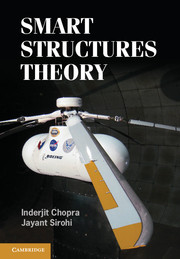Book contents
- Frontmatter
- Contents
- Preface
- 1 Historical Developments and Potential Applications: Smart Materials and Structures
- 2 Piezoelectric Actuators and Sensors
- 3 Shape Memory Alloys (SMAs)
- 4 Beam Modeling with Induced-Strain Actuation
- 5 Plate Modeling with Induced-Strain Actuation
- 6 Magnetostrictives and Electrostrictives
- 7 Electrorheological and Magnetorheological Fluids
- 8 Applications of Active Materials in Integrated Systems
- Index
- References
2 - Piezoelectric Actuators and Sensors
Published online by Cambridge University Press: 18 December 2013
- Frontmatter
- Contents
- Preface
- 1 Historical Developments and Potential Applications: Smart Materials and Structures
- 2 Piezoelectric Actuators and Sensors
- 3 Shape Memory Alloys (SMAs)
- 4 Beam Modeling with Induced-Strain Actuation
- 5 Plate Modeling with Induced-Strain Actuation
- 6 Magnetostrictives and Electrostrictives
- 7 Electrorheological and Magnetorheological Fluids
- 8 Applications of Active Materials in Integrated Systems
- Index
- References
Summary
Fundamentals of Piezoelectricity
The term “piezoelectricity” translates roughly to “pressure electricity” and refers to an effect observed in many naturally occurring crystals; that is, the generation of electricity under mechanical pressure. The effect was first predicted and then experimentally measured by the brothers Pierre and Jacques Curie in 1880. The research was prompted by investigations into a closely related effect, the pyroelectric effect, which is the generation of electricity as a result of a change in temperature. The effect observed by the Curie brothers is also known as the direct piezoelectric effect. A strict definition of the direct effect is “electric polarization produced by mechanical strain, being directly proportional to the applied strain.” A converse piezoelectric effect also exists and is the appearance of mechanical strain as a result of an applied electric field.
The origin of the piezoelectric effect can be traced to fundamental geometric properties of certain crystals. Based on their geometry, crystals are normally classified into seven categories: triclinic, monoclinic, orthorhombic, tetragonal, trigonal, hexagonal, and cubic. A structure is called centrosymmetric if it has symmetry with respect to a single point. Based on their symmetry with respect to a point, the crystals are further classified into 32 classes, of which only 20 classes can exhibit piezoelectricity. The unit cell of these crystals possesses a certain degree of asymmetry, leading to a separation of positive and negative charges that results in a permanent polarization.
- Type
- Chapter
- Information
- Smart Structures Theory , pp. 113 - 193Publisher: Cambridge University PressPrint publication year: 2013
References
- 1
- Cited by



